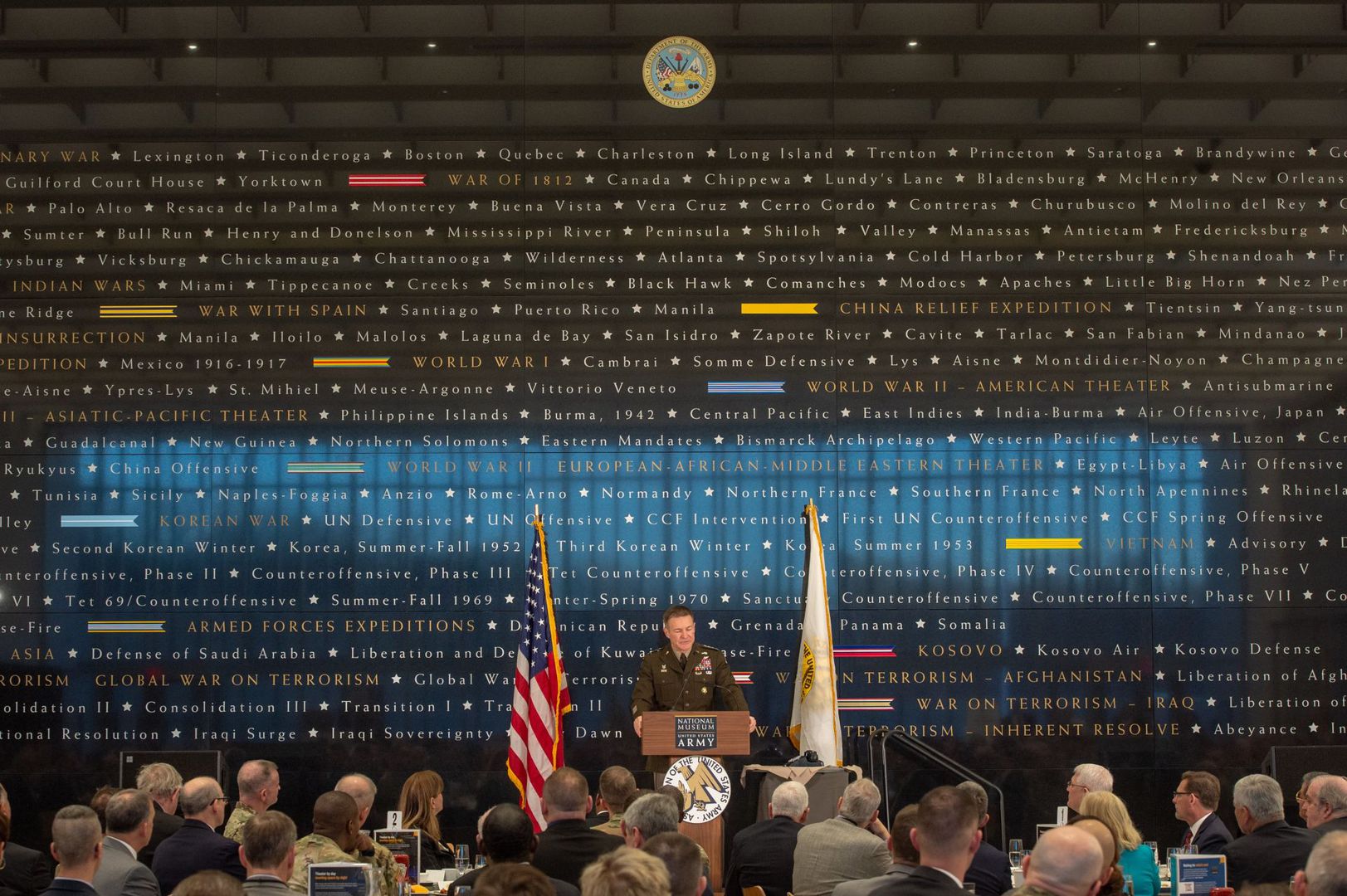FORT BELVOIR: The Army must engage in “transformational change” — not incremental improvements — to achieve overmatch, deter great-power competition, and win the future fight, the Army’s top officer said Tuesday.
“‘People first, winning matters,’ is more than just a slogan,” said Army Chief of Staff Gen. James McConville. “People first is a philosophy … winning matters is an attitude.”
“[Secretary of the Army Ryan McCarthy] and I aren’t trying to fight the last fight better. We’re focused on winning the next fight. To do that, we recognize the need for transformational change,” he added.
McConville spoke during an Association of the U.S. Army breakfast at the National Museum of the U.S. Army, slated to open on June 4.
To illustrate the difference between incremental and transformational change, McConville held up an old corded telephone and discussed various marginal upgrades made to the technology.
The chief later held up a smartphone device and highlighted the importance of innovators in the Army.
“[Mobile technology] transformed our understanding of what a phone could be,” McConville said. “It navigates, it takes photos, it does hundreds of other functions we never imagined 40 years ago.
“New and different perspectives are necessary for innovation,” he added. “We have to encourage innovation; look for it in unexpected places, and we must embrace it when we find it.”
A NEED FOR CHANGE
The Army’s last significant transformational change happened in the late 1970s and 80s, following its role in the Vietnam conflict, McConville said. Lessons learned during Vietnam aided in the development of the Air-Land Battle doctrine, which revolutionized the way the Army engaged in conflict.
Around the same time, the force also modernized its fighting systems with the inclusion of the “Big Five” — the M1 Abrams tank, Bradley Fighting Vehicle, Apache and Black Hawk helicopters, and the Patriot missile system, McConville said. The nation’s engagement in great-power competition with the Soviet Union led to many technological advances and reshaped the character of war.
“Think about it, we began building the Army of 2020 more than 40 years ago, and since then we incrementally improved our weapons systems that we fielded in the 1970s and 1980s,” McConville said.
Now, the Army is reaching the limitations of its current technology, all while simultaneously having to compete in a modern battlefield across multiple domains — land, air, sea, space, and cyberspace, he said.
“I would submit that we are at a similar inflection point to the one our leaders faced coming out of Vietnam,” he said. “We have to ask ourselves, ‘Are we building the Army that can compete and win for the next 40 years?'”
MODERNIZING THE FORCE
Moving forward, Army leaders have recognized a need for transformational change, McConville said.
“That is exactly what we are doing with the development of the multi-domain operations concept,” he said. “That’s why we’re building new organizations like the security force assistance brigades, multi-domain task forces, and the Information Warfare Command.
“That’s why we’re laser-focused on developing and fielding the six modernization priorities with 31 signature systems,” he added. “And that’s why we must implement a 21st-century talent management system.”
The force has started to find success with the implementation of its modernization strategy. Under the Long-Range Precision Fires, or LRPF, portfolio, the Army recently test fired its new precision strike missile and extended-range cannon, both of which exhibited increased ranges.
Improvements to the LRPF systems could be fielded in the next three years, McConville said.
The Army is also looking to field mobile short-range air defense systems by next year. The Integrated Battle Command System, which links multiple sensors and shooters on the battlefield, is also being developed to provide “a more holistic defense against enemy air missiles and unmanned aerial systems,” he said.
The Army’s Future Vertical Lift Cross-Functional Team is currently “flying before buying,” as they develop the Future Long-Range Assault Aircraft and Future Attack Reconnaissance Aircraft, McConville said.
“Note, these are aircraft and not helicopters because of the transformational requirements we asked from industry are not resonant in traditional helicopters,” he added.
The Army has also made changes to some of the requirements under the Next-Generation Combat Vehicle portfolio, McConville said. Last week, the Army decided to halt and revise a solicitation for the development of an Optionally-Manned Fighting Vehicle.
“We are fully committed to replacing the Bradley Fighting Vehicle in the future,” McConville said. “However, like the future vertical aircraft, we want to [prototype and drive] these before we buy them.
“We found early in the process, after minimal investments, that our aggressive timeline did not permit industry to meet the requirements,” he added. “We have taken a tactical pause, and we are going to reset the requirements … the acquisition strategy and timeline. Then we’re going to come out and aggressively pursue this critical weapon system that we need for the future.”











